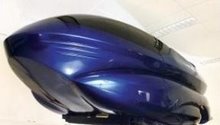An all-electric aircraft could soon appear over the horizon thanks to high-flying scientific research published today in the Institute of Physics' journal, Superconductor Science and Technology. The new type of aircraft, currently on the drawing board, could be far more efficient than conventional aircraft, produce less greenhouse emissions, and be quieter.
Air travel is on the increase, but it comes at a price in terms of the emissions driving climate change. Aircraft currently account for about 5% of UK emissions with a single long-haul flight the equivalent of a ton of carbon dioxide per passenger. With such worrying figures making the headlines, alternatives to combustion-based propulsion systems could be the key.
Superconducting motors could be one such alternative, according to scientists in America. Philippe Masson and Cesar Luongo from Florida State University, who have collaborated with Gerald Brown at NASA and Danielle Soban at Georgia Institute of Technology, explain that because superconductors lose no energy through electrical resistance, they could be very efficient components for a new type of aircraft propulsion.
The researchers explain that to build an electric aircraft will require propulsion motors that are high power, lightweight and compact. Current technology cannot meet these demands because an electric motor using conventional magnets can weigh up to five times as much as conventional jet engine and not be as fuel efficient.
In contrast, a superconducting motor would be very lightweight and far more efficient electrically, generating three times the torque of a conventional electric motor for the same energy input and weight. In addition, an electric aircraft would be far quieter than a conventional jet as there are no internal combustion processes involved. It is the combustion of fossil fuels to drive a conventional aircraft that makes them so noisy.
However, superconducting magnets not only have to be cold, but require a unique energy supply. Masson and his colleagues believe they could solve both problems by using chilly liquid hydrogen to run an electric fuel cell. Liquid hydrogen is cold enough to make the superconducting magnets work but also has four times as much energy weight for weight than aviation fuel.
A fuel cell produces no polluting emissions, just warm water as the hydrogen combines with oxygen. This, say the researchers would mean zero carbon emissions from the aircraft as it flies. "The idea is to reduce the emissions from the aircraft and airports," explains team leader Masson, "The energy needed to produce the liquid hydrogen could come from a remote powerplant". Such a powerplant might be solar or wind powered.
"We could potentially build a superconducting motor and generator smaller than a gas turbine, which would make possible electric propulsion," says Masson. Electrical propulsion would not only decrease emissions but also reduce to a minimum the needs for maintenance as all hydraulic systems would be eliminated, he adds. The team has designed such systems with high fidelity models and optimization tools.
Masson adds that the team is now looking for an industrial partner to build a prototype of the superconducting "turbofan". "The technology is there," he says, "it is a matter of finding a source of funding."
Original Source: Institute of Physics, News
________________________________________________________
________________________________________________________
skip to main |
skip to sidebar




Sailing thru the vastness of Space on the mothership Earth, Journeying thru Time.



Missions
ASTRO BLOGS
Space Sciences
About Me
SpaceCraft
